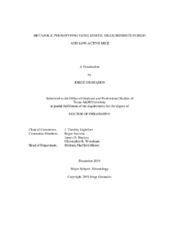| dc.description.abstract | Physical activity is well known to diminish the occurrence of many diseases, yet fewer than 10% of American adults adhere to recommended physical activity guidelines. Thus, there is a critical need to identify the biological mechanism(s) associated with the regulation of physical activity adherence. To better understand the mechanism(s) associated with regulating physical activity levels, we have extensively studied inbred mice previously classified as low-active (LA) or high-active (HA) and found several differentially expressed muscle and brain proteins that may be involved in metabolism. These proteomic findings suggest potential amino acid, metabolite, and enzymatic pathways, which may be associated with the differential physical activity levels in HA and LA mice. As such, the purpose of this dissertation was to conduct an exploratory metabolic phenotyping assessment of amino acid kinetics in HA and LA mice. Methods consisted of administering a stable isotope tracer pulse cocktail containing several amino acids and metabolites. Subsequently, blood samples were collected at different time points (Time: 1, 3, 5, 7, 10, 15, 20, 25, 30, and 40 min) for liquid chromatography-tandem mass spectrometry assessment of plasma enrichments and concentrations of the infused tracers. Amino acid whole-body production and clearance were calculated.
This untargeted assessment identified differences in several amino acid pathways related to 1) modified arginine and nitric oxide production; 2) augmented energy flux via increased isoleucine and valine anaplerosis; 3) potential increases of dopamine via increased phenylalanine and tyrosine metabolism. In conclusion, the observed differences in amino acid metabolism may be associated with the regulation of varying physical activity levels in HA and LA mice. Additionally, the identified metabolic pathways will serve as a foundation for follow-up intervention studies in the HA and LA mice. | en |


